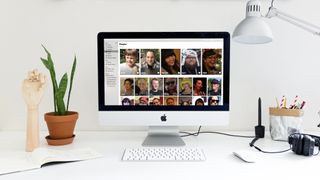
Apple's photo management software for the Mac, Photos, has grown to be a fairly competent all-purpose storage locker. But as your photo and video library grows — and especially if you've taken advantage of iCloud Photo Library — you may find that your Photos library strains to fit on your Mac's hard drive.
While there are options to keep your Mac from running out of space, like optimizing your photo storage if you use iCloud Photo Library, it comes at a cost: Without a fully-stored Photos library, you won't be able to create secondary backups of your images and video. (And as good as iCloud has become, your photos and video are precious enough that they're worth keeping backed up in multiple places.)
There is an alternative: Moving your Photos library to an external drive (or creating an entirely separate library and syncing it with iCloud). Here's how to do it, and some reasons why you should — and shouldn't! — consider it for your needs.
Why you should (and shouldn't) use an external drive with Photos for Mac
There are a number of reasons why an external drive might make sense when you're working with Photos for Mac:
- You have a giant Photos library (and, if you use iCloud Photo Library, you want to ensure you have a secondary backup of everything in that library)
- You frequently swap computers and want to work on your images from any Mac
- Your library isn't huge, but you'd prefer to save space on your Mac for other files
- You share a computer with other users and you have limited drive space
- If you're working with space constraints on your primary computer, it's one of the easiest ways to back up your full iCloud Photo Library
That said, there are some downsides, too. Here are some reasons you might not want to use an external drive:
- You don't have a big enough library to warrant moving it off your Mac
- You don't want to have to worry about always having your external drive connected to view and edit your images
- You use a laptop frequently and can't afford an SSD, and you don't want to risk breaking your disc-based hard drive by constantly moving it
- You don't want to accidentally create duplicate libraries that can't be connected to iCloud Photo Library (because your offsite library is connected)
- Unless you purchase a speedy drive, working externally is almost always slower than working on your default hard drive
- You don't want to spend the money on an external drive
- If you use an automated backup service for your computer, you'll have to set up a second set of rules for backing up your hard drive
Best external drives for storing photos
Okay, so you've decided to move your Photos library over to an external drive. What next? If you already have an external drive, you can always use it for storing your Photos library (and save on cash). But if you're considering getting a new drive for this endeavor, here's what I suggest:
- Get a drive that's at least 1-2TB in space, preferably 4TB. With the iPhone able to save 4K video, our space needs aren't shrinking anytime soon: The bigger hard drive you can afford, the better.
- If you're buying a stationary hard drive, buying a disc-based hard drive is great, but buy good brands — don't try and save $50 on an off-brand hard drive. It's rarely worth the HDD failure.
- If you're buying a portable hard drive, consider SSD: It's very pricey in comparison to a disc-based drive, but if you know you'll be frequently moving around — especially if you plan to move around with the drive connected — you want a drive that can take a little rumble and tumble without skipping or failing.
- Hard drive speeds are important, too: The faster a drive's write speed, the quicker your images will copy; the faster a drive's read speed, the easier it will be for you to view images or video and edit them, too.
Want some recommendations for specific external hard drives? We've got those, too.
Master your iPhone in minutes
iMore offers spot-on advice and guidance from our team of experts, with decades of Apple device experience to lean on. Learn more with iMore!
- Best USB-C Hard Drives for Mac
- Best External Hard Drives for Mac
- Best Shock-Resistant Hard Drives for Mac
How to move your current Photos library to an external drive and use it as your primary library
As with creating a new library, moving your library to your external drive is a multi-step process. Here's how to go about it.
Step 1: Copy over your Photos library
- Connect an external drive to your Mac via USB, USB-C, or Thunderbolt.
- Open a new Finder window.
- Open your external drive in that window.
- Open a new Finder window. Don't close your previous window (open to your external drive), as you'll need it shortly.

- Click the Go menu and navigate to your Home folder.
- Select the Pictures folder.
- Select your old library.
- Drag it to your external drive in the other Finder window.

Your library will begin to copy over to your external drive. Depending on the size of your library and speed of your drive, this can take anywhere from a few minutes to several hours, so be patient. Don't unplug your drive or turn off your computer during this process.
Step 2 (if you use iCloud): Turn off iCloud sync on your old library
Before you open your copied Photos library on the external drive, you have to disassociate the library on your Mac from iCloud. (If you don't use iCloud Photo Library, you can skip these steps.)
- Open Photos on your Mac.
- Go to the Photos menu.
- Select Settings.
- Click on the iCloud tab.
- Uncheck iCloud Photos.

- Press Remove from Mac to remove any undownloaded low-resolution items from this library.
- Quit Photos.
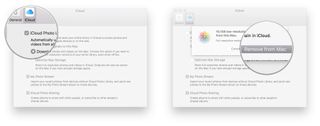
Step 3: Make your new library your system default
Now, it's time to make your newly-copied Photos library your system default.
- Open Photos on your Mac.
- Go to the Photos menu.
- Select Settings.
- Click Use as System Photo Library.
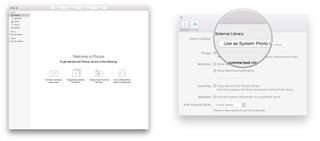
Step 4 (if you use iCloud): Connect your new library to iCloud
Your external library is now set up to be your system default, but it's not currently connected to iCloud. If you use iCloud Photo Library and want to keep that connection active so that you can continually download items you've stored, read on. (Otherwise, you can skip this step.)
- Open Photos on your Mac.
- Go to the Photos menu.
- Select Preferences.
- Click on the iCloud tab.
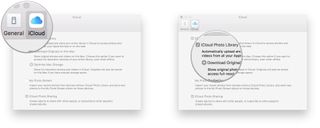
- Check iCloud Photos.
- Click Download Originals to this Mac.
- Wait for your Mac to download your images from iCloud. (Depending on the size of your iCloud library and your internet connection, this may take up to 24 hours; don't disconnect your external drive or turn off your Mac during this time.)
Once your library has fully synced and downloaded images, you can disconnect your drive; whenever you want to use your Photos library, you now need to connect your drive to your Mac.
Step 5: Get rid of your old library
A personal plea: Please, please, please make sure your library is fully copied and working on your external drive before you follow the steps below — once you've thrown away your original library, it's gone!
- Open a new Finder window.
- Click the Go menu and navigate to your Home folder.
- Select the Pictures folder.
- Select your old library.

- Drag it to the Trash (or press Command-Delete on your keyboard).
- Empty the Trash.
- Open a new Finder window. Don't close your previous window (open to the Pictures folder), as you'll need it later.
- Select your external drive.
- Right-click (or control-click) on your copied Photos library on your external drive.
- Select Make Alias.
- Drag the alias to the Pictures folder.
- Rename the alias to remove the "alias" part of its name.

Now you have a direct link to your copied Photos library from the Pictures folder: This prevents your computer from accidentally creating multiple Photos libraries in case you forget to launch Photos with your external drive connected.
Note: If you're worried about accidentally creating libraries, you can always launch Photos by option-clicking on its icon in the Dock or Applications folder; this will give you the option of picking which library you'd like to launch.
How to create a new Photos library on your external drive and use it as your primary library
Creating a new library on your external drive is a multi-step process. Here's how to go about it.
Step 1 (if you use iCloud): Turn off iCloud sync on your old library
Before you create a new Photos library, you have to disassociate your current library as your system default. (If you don't use iCloud Photos, you can skip these steps.)
- Open Photos on your Mac.
- Go to the Photos menu.
- Select Preferences.
- Click on the iCloud tab.

- Uncheck iCloud Photos.
- Press Remove from Mac to remove all low-resolution items from this library.
- Press Remove from Mac once more to confirm.
- Quit Photos.
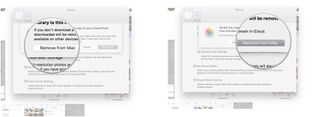
Step 2: Create your new Photos library
Once you've done this, it's time to create a new library.
- Connect an external drive to your Mac via USB, USB-C, or Thunderbolt.
- Option-click (and continue holding down option) when launching the Photos app on your Mac.
- When it asks you to choose a library, click on Create New….
- Name your library.

- Press the Down arrow to expand the File picker and choose your external drive as the new location.
- Press OK to save it to your external drive.
Step 3: Make your new library your system default
You'll now have an empty library on your external drive. Next up: Making it your system library.
- Open Photos on your Mac.
- Go to the Photos menu.
- Select Preferences.
- Click Use as System Photo Library.

Step 4 (if you use iCloud): Connect your new library to iCloud
Your external library has now been set up from scratch. If you use iCloud Photos and want to download all the items you've stored there to have an external backup, read on. (Otherwise, you can skip this step.)
- Open Photos on your Mac.
- Go to the Photos menu.
- Select Preferences.
- Click on the iCloud tab.

- Check iCloud Photos.
- Click Download Originals to this Mac.
- Wait for your Mac to download your images from iCloud. (Depending on the size of your library and your internet connection, this may take up to 24 hours; don't disconnect your external drive or turn off your Mac during this time.)
Once your library has fully synced and downloaded images, you can disconnect your drive; whenever you want to use your Photos library, you now need to connect your drive to your Mac.
Step 5: Get rid of your old library
A personal plea: Please, please, please make sure your new library is live and working on your external drive before you follow the steps below — once you've thrown away your original library, it's gone!
- Open a new Finder window.
- Click the Go menu and navigate to your Home folder.
- Select the Pictures folder.
- Select your old library.

- Drag it to the Trash (or press Command-Delete on your keyboard).
- Empty the Trash.
- Open a new Finder window. Don't close your previous window (open to the Pictures folder), as you'll need it later.
- Select your external drive.
- Right-click (or control-click) on your new Photos library.
- Select Make Alias.

- Drag the alias to the Pictures folder.
- Rename the alias to remove the "alias" part of its name.
Now you have a direct link to your Photos library from the Pictures folder: This prevents your computer from accidentally creating multiple Photos libraries in case you forget to launch Photos with your external drive connected.
Note: If you're worried about accidentally creating libraries, you can always launch Photos by option-clicking on its icon in the Dock or Applications folder; this will give you the option of picking which library you'd like to launch.
Running a cleaner Mac
Moving your Photos library to an external will free up valuable space on your internal hard drive. Just make sure you connect the external hard drive whenever you plan to use the Photos library, to avoid confusion or multiple libraries. Now your Mac will have less files and photos weighing it down! If it's still running tight, you may need to look for other solutions to free up space, or upgrade to a newer Mac with more storage space.
Updated December 2022: Updated for the latest version of macOS.

iMore.com is your source for all things Apple, and the IM Staff author represents our collective hivemind, for those occasions when the whole team speaks with one voice to bring you important updates about the site, editorial policies, awards, promotions and more.
The iMore team of Apple enthusiasts and experts shows you how to get the most out of your tech life by using Apple products and the apps, services, and devices they connect with to their fullest. iMore is a mainstay in the Apple community for good reason. Every single iMore writer and editor takes their job seriously, and we prioritize accuracy and editorial independence in everything we do, never receiving compensation for coverage and never pulling punches.
As well as our amazing group of regular contributors, the iMore staff team currently consists of:
Gerald Lynch — Editor-in-Chief
Stephen Warwick — News Editor
Daryl Baxter — Features Editor
John-Anthony Disotto — How To Editor
Tammy Rogers — Senior Staff Writer
James Bentley — Staff Writer
Most Popular


